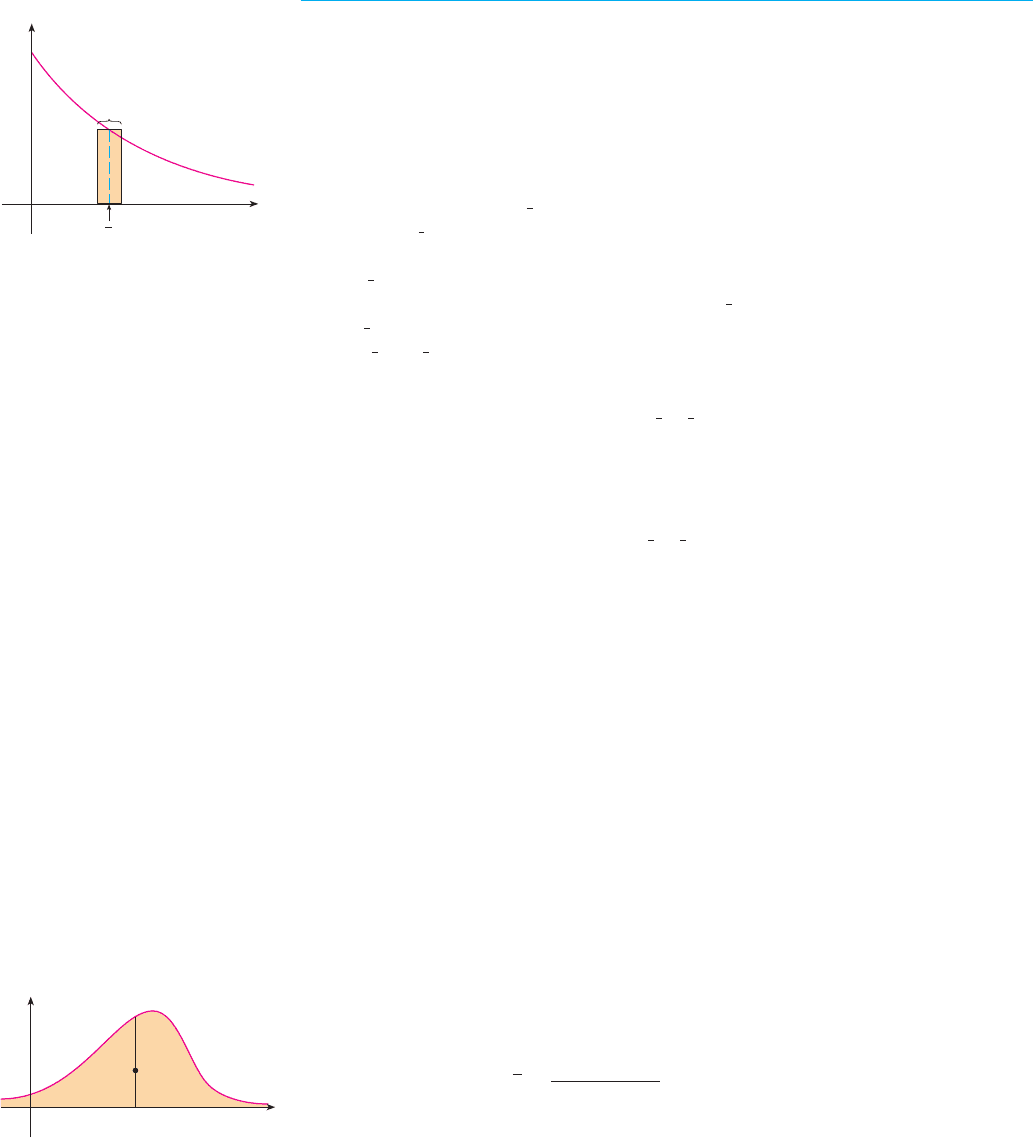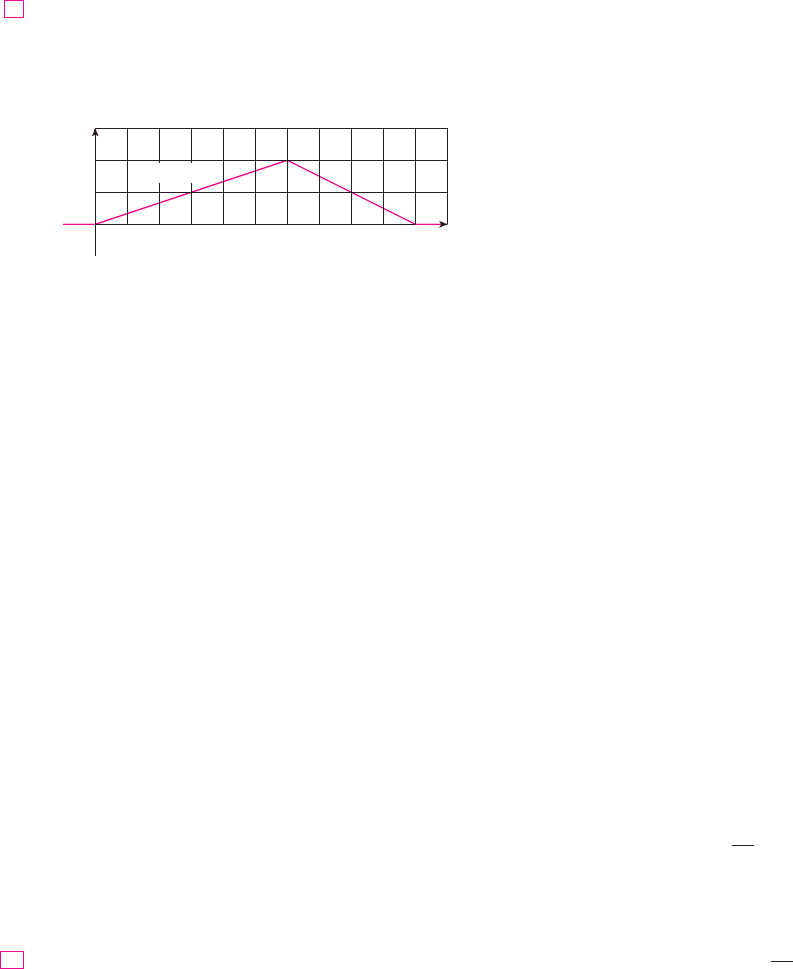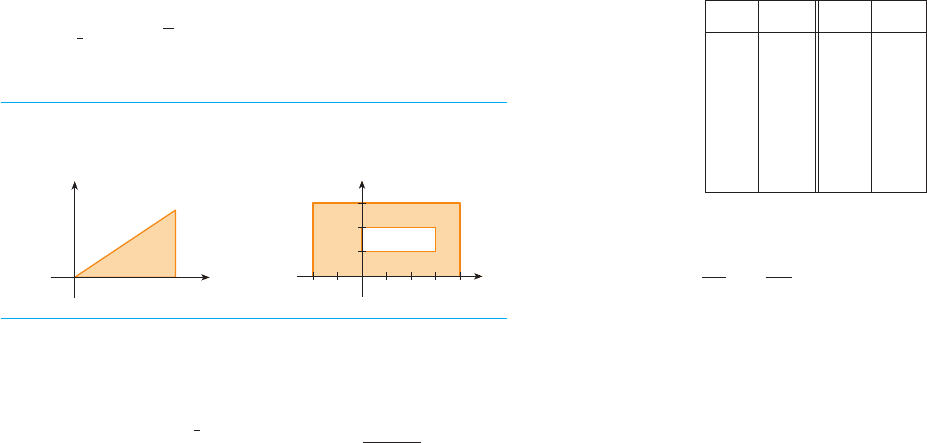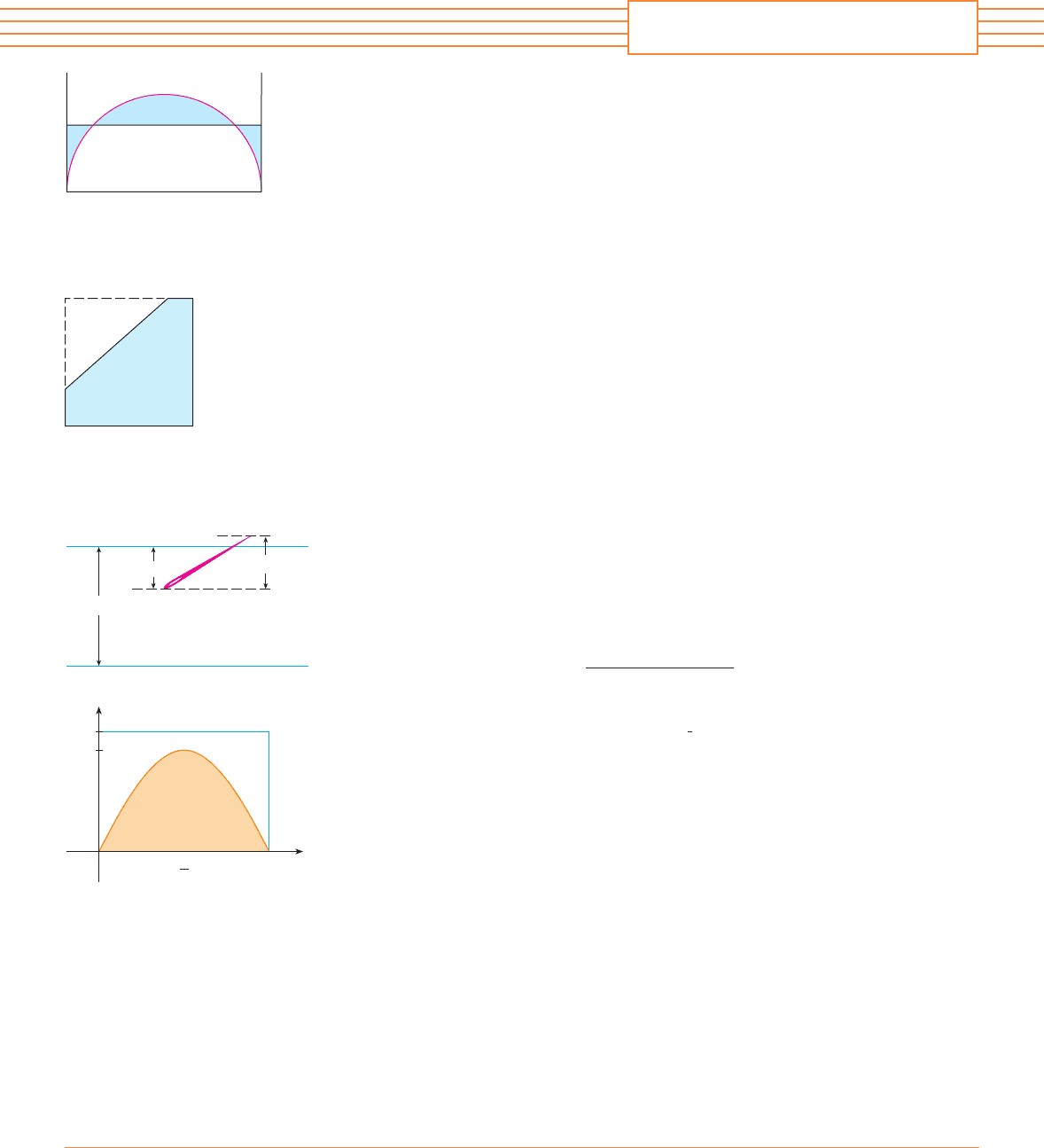Stewart J. Calculus
Подождите немного. Документ загружается.


SOLUTION
(a) For we have , so for all . We also need to
check that Equation 2 is satisfied:
Therefore is a probability density function.
(b) The probability that lies between 4 and 8 is
M
EXAMPLE 2 Phenomena such as waiting times and equipment failure times are com-
monly modeled by exponentially decreasing probability density functions. Find the exact
form of such a function.
SOLUTION Think of the random variable as being the time you wait on hold before an
agent of a company you’re telephoning answers your call. So instead of x, let’s use t to
represent time, in minutes. If is the probability density function and you call at time
, then, from Definition 1, represents the probability that an agent answers
within the first two minutes and is the probability that your call is answered
during the fifth minute.
It’s clear that for (the agent can’t answer before you place the call).
For we are told to use an exponentially decreasing function, that is, a function of
the form , where A and c are positive constants. Thus
We use Equation 2 to determine the value of A:
Therefore and so . Thus every exponential density function has the form
A typical graph is shown in Figure 2.
M
f "t# !
(
0
ce
"ct
if t
)
0
if t ( 0
A ! cA!c ! 1
!
A
c
! lim
x
l
'
)
"
A
c
e
"ct
*
0
x
! lim
x
l
'
A
c
"1 " e
"cx
#
!
y
'
0
Ae
"ct
dt ! lim
x
l
'
y
x
0
Ae
"ct
dt
1 !
y
'
"'
f "t# dt !
y
0
"'
f "t# dt $
y
'
0
f "t# dt
f "t# !
(
0
Ae
"ct
if t
)
0
if t ( 0
f "t# ! Ae
"ct
t % 0
t
)
0f "t# ! 0
x
5
4
f "t# dt
x
2
0
f "t# dtt ! 0
f
V
! 0.006
[
5x
2
"
1
3
x
3
]
4
8
! 0.544
P"4 ! X ! 8# !
y
8
4
f "x# dx ! 0.006
y
8
4
"10x " x
2
# dx
X
f
! 0.006
[
5x
2
"
1
3
x
3
]
0
10
! 0.006
(
500 "
1000
3
)
! 1
y
'
"'
f "x# dx !
y
10
0
0.006x"10 " x# dx ! 0.006
y
10
0
"10x " x
2
# dx
xf "x# ( 00.006x"10 " x# ( 00 ! x ! 10
592
|| ||
CHAPTER 9 FURTHER APPLICATIONS OF INTEGRATION
F I G U R E 2
An exponential density function
0
f(t)=
0
ce
_ct
if
t<0
if
t˘0
t
y
c

AVE R AG E VALUES
Suppose you’re waiting for a company to answer your phone call and you wonder how
long, on average, you can expect to wait. Let be the corresponding density function,
where t is measured in minutes, and think of a sample of N people who have called this
company. Most likely, none of them had to wait more than an hour, so let’s restrict our
attention to the interval . Let’s divide that interval into n intervals of length
and endpoints . . . . (Think of as lasting a minute, or half a minute, or 10 sec-
onds, or even a second.) The probability that somebody’s call gets answered during the
time period from to is the area under the curve from to , which is
approximately equal to . (This is the area of the approximating rectangle in Fig-
ure 3, where is the midpoint of the interval.)
Since the long-run proportion of calls that get answered in the time period from to
is , we expect that, out of our sample of N callers, the number whose call was
answered in that time period is approximately and the time that each waited is
about . Therefore the total time they waited is the product of these numbers: approxi-
mately . Adding over all such intervals, we get the approximate total of every-
body’s waiting times:
If we now divide by the number of callers N, we get the approximate average waiting time:
We recognize this as a Riemann sum for the function . As the time interval shrinks
(that is, and ), this Riemann sum approaches the integral
This integral is called the mean waiting time.
In general, the mean of any probability density function is defined to be
The mean can be interpreted as the long-run average value of the random variable X. It can
also be interpreted as a measure of centrality of the probability density function.
The expression for the mean resembles an integral we have seen before. If is the
region that lies under the graph of , we know from Formula 9.3.8 that the x-coordinate of
the centroid of is
because of Equation 2. So a thin plate in the shape of balances at a point on the vertical
line . (See Figure 4.)x !
*
!
x !
y
'
"'
x f "x# dx
y
'
"'
f "x# dx
!
y
'
"'
x f "x# dx !
*
!
f
!
*
!
y
'
"'
x f "x# dx
f
y
60
0
t f "t# dt
n l '+t l 0
t f "t#
+
n
i!1
t
i
f "t
i
# +t
+
n
i!1
N t
i
f "t
i
# +t
t
i
&N f "t
i
# +t'
t
i
N f "t
i
# +t
f "t
i
# +tt
i
t
i"1
t
i
f "t
i
# +t
t
i
t
i"1
y ! f "t#t
i
t
i"1
+tt
60
0, t
1
, t
2
,
+t0 ! t ! 60
f "t#
SECTION 9.5 PROBABILITY
|| ||
593
0
t t
i
t
i
y= f(t)
F I G U R E 3
t
y
Ît
t
i-1
N It is traditional to denote the mean by the
Greek letter (mu).
*
F I G U R E 4
T balances at a point on the line x=m
0
m
y= ƒ
x=m
T
t
y

EXAMPLE 3 Find the mean of the exponential distribution of Example 2:
SOLUTION According to the definition of a mean, we have
To evaluate this integral we use integration by parts, with and :
The mean is , so we can rewrite the probability density function as
M
EXAMPLE 4 Suppose the average waiting time for a customer’s call to be answered
by a company representative is five minutes.
(a) Find the probability that a call is answered during the first minute.
(b) Find the probability that a customer waits more than five minutes to be answered.
SOLUTION
(a) We are given that the mean of the exponential distribution is min and so,
from the result of Example 3, we know that the probability density function is
Thus the probability that a call is answered during the first minute is
So about 18% of customers’ calls are answered during the first minute.
(b) The probability that a customer waits more than five minutes is
About 37% of customers wait more than five minutes before their calls are answered.
M
!
1
e
, 0.368
! lim
x
l
'
y
x
5
0.2e
"t!5
dt ! lim
x
l
'
"e
"1
" e
"x!5
#
P"T % 5# !
y
'
5
f "t# dt !
y
'
5
0.2e
"t!5
dt
! 1 " e
"1!5
, 0.1813
! 0.2""5#e
"t!5
]
0
1
!
y
1
0
0.2e
"t!5
dt
P"0 ! T ! 1# !
y
1
0
f "t# dt
f "t# !
(
0
0.2e
"t!5
if t
)
0
if t ( 0
*
! 5
V
f "t# !
(
0
*
"1
e
"t!
*
if t
)
0
if t ( 0
*
! 1!c
! lim
x
l
'
$
"xe
"cx
$
1
c
"
e
"cx
c
%
!
1
c
y
'
0
tce
"ct
dt ! lim
x
l
'
y
x
0
tce
"ct
dt ! lim
x
l
'
$
"te
"ct
]
x
0
$
y
x
0
e
"ct
dt
%
dv ! ce
"ct
dtu ! t
*
!
y
'
"'
t f "t# dt !
y
'
0
tce
"ct
dt
f "t# !
(
0
ce
"ct
if t
)
0
if t ( 0
594
|| ||
CHAPTER 9 FURTHER APPLICATIONS OF INTEGRATION
N The limit of the first term is by
l’Hospital’s Rule.
0

Notice the result of Example 4(b): Even though the mean waiting time is 5 minutes,
only 37% of callers wait more than 5 minutes. The reason is that some callers have to wait
much longer (maybe 10 or 15 minutes), and this brings up the average.
Another measure of centrality of a probability density function is the median. That is a
number m such that half the callers have a waiting time less than m and the other callers
have a waiting time longer than m. In general, the median of a probability density func-
tion is the number m such that
This means that half the area under the graph of lies to the right of m. In Exercise 9 you
are asked to show that the median waiting time for the company described in Example 4
is approximately 3.5 minutes.
NORMAL DISTRI B U T I O N S
Many important random phenomena—such as test scores on aptitude tests, heights and
weights of individuals from a homogeneous population, annual rainfall in a given loca-
tion—are modeled by a normal distribution. This means that the probability density
function of the random variable X is a member of the family of functions
You can verify that the mean for this function is . The positive constant is called the
standard deviation; it measures how spread out the values of X are. From the bell-shaped
graphs of members of the family in Figure 5, we see that for small values of the values
of X are clustered about the mean, whereas for larger values of the values of X are more
spread out. Statisticians have methods for using sets of data to estimate and .
The factor is needed to make a probability density function. In fact, it can
be verified using the methods of multivariable calculus that
EXAMPLE 5 Intelligence Quotient (IQ) scores are distributed normally with mean
100 and standard deviation 15. (Figure 6 shows the corresponding probability density
function.)
(a) What percentage of the population has an IQ score between 85 and 115?
(b) What percentage of the population has an IQ above 140?
V
y
'
"'
1
,
s
2
-
e
""x"
*
#
2
!"2
,
2
#
dx ! 1
f1!
(
,
s
2
-
)
F I G U R E 5
Normal distributions
x
y
0
m
1
2
s=2
s=1
s=
,
*
,
,
,
*
f "x# !
1
,
s
2
-
e
""x"
*
#
2
!"2
,
2
#
3
f
y
'
m
f "x# dx !
1
2
SECTION 9.5 PROBABILITY
|| ||
595
N The standard deviation is denoted by the
lowercase Greek letter (sigma).
,
F I G U R E 6
Distribution of IQ scores
x
y
0
60
0.01
80 100 120 140
0.02

SOLUTION
(a) Since IQ scores are normally distributed, we use the probability density function
given by Equation 3 with and :
Recall from Section 8.5 that the function doesn’t have an elementary anti-
derivative, so we can’t evaluate the integral exactly. But we can use the numerical
integration capability of a calculator or computer (or the Midpoint Rule or Simpson’s
Rule) to estimate the integral. Doing so, we find that
So about 68% of the population has an IQ between 85 and 115, that is, within one stan-
dard deviation of the mean.
(b) The probability that the IQ score of a person chosen at random is more than 140 is
To avoid the improper integral we could approximate it by the integral from 140 to 200.
(It’s quite safe to say that people with an IQ over 200 are extremely rare.) Then
Therefore about 0.4% of the population has an IQ over 140.
M
P"X % 140# ,
y
200
140
1
15
s
2
-
e
""x"100#
2
!450
dx , 0.0038
P"X % 140# !
y
'
140
1
15
s
2
-
e
""x"100#
2
!450
dx
P"85 ! X ! 115# , 0.68
y ! e
"x
2
P"85 ! X ! 115# !
y
115
85
1
15
s
2
-
e
""x"100#
2
!"2! 15
2
#
dx
,
! 15
*
! 100
596
|| ||
CHAPTER 9 FURTHER APPLICATIONS OF INTEGRATION
5. Let .
(a) For what value of is a probability density function?
(b) For that value of , find .
6. Let if and if
or .
(a) For what value of is a probability density function?
(b) For that value of , find .
(c) Find the mean.
A spinner from a board game randomly indicates a real number
between 0 and 10. The spinner is fair in the sense that it indi-
cates a number in a given interval with the same probability as
it indicates a number in any other interval of the same length.
(a) Explain why the function
is a probability density function for the spinner’s values.
(b) What does your intuition tell you about the value of the
mean? Check your guess by evaluating an integral.
f "x# !
(
0.1
0
if 0 ! x ! 10
if x
)
0 or x % 10
7.
P
(
X (
1
2
)
k
fk
x % 1
x
)
0f "x# ! 00 ! x ! 1f "x# ! kx
2
"1 " x#
P""1
)
X
)
1#c
fc
f "x# ! c!"1 $ x
2
#
Let be the probability density function for the lifetime of a
manufacturer’s highest quality car tire, where is measured in
miles. Explain the meaning of each integral.
(a) (b)
2. Let be the probability density function for the time it takes
you to drive to school in the morning, where is measured in
minutes. Express the following probabilities as integrals.
(a) The probability that you drive to school in less than
15 minutes
(b) The probability that it takes you more than half an hour to
get to school
3. Let for and for all
other values of .
(a) Verify that is a probability density function.
(b) Find .
4. Let if and if .
(a) Verify that is a probability density function.
(b) Find .P"1 ! X ! 2#
f
x
)
0f "x# ! 0x ( 0f "x# ! xe
"x
P(X
)
2#
f
x
f "x# ! 00 ! x ! 4f "x# !
3
64
x
s
16 " x
2
t
f "t#
y
'
25,000
f "x# dx
y
40,000
30,000
f "x# dx
x
f "x#
1.
E X E R C I S E S
9.5

of 500 g. At what target weight should the manufacturer set its
filling machine?
15. The speeds of vehicles on a highway with speed limit
are normally distributed with mean and standard
deviation .
(a) What is the probability that a randomly chosen vehicle is
traveling at a legal speed?
(b) If police are instructed to ticket motorists driving
or more, what percentage of motorists are targeted?
16. Show that the probability density function for a normally dis-
tributed random variable has inflection points at .
17. For any normal distribution, find the probability that the
random variable lies within two standard deviations of the
mean.
18. The standard deviation for a random variable with probability
density function and mean is defined by
Find the standard deviation for an exponential density function
with mean .
19. The hydrogen atom is composed of one proton in the nucleus
and one electron, which moves about the nucleus. In the quan-
tum theory of atomic structure, it is assumed that the electron
does not move in a well-defined orbit. Instead, it occupies a
state known as an orbital, which may be thought of as a
“cloud” of negative charge surrounding the nucleus. At the
state of lowest energy, called the ground state, or 1s-orbital,
the shape of this cloud is assumed to be a sphere centered at
the nucleus. This sphere is described in terms of the probability
density function
where is the Bohr radius . The
integral
gives the probability that the electron will be found within the
sphere of radius meters centered at the nucleus.
(a) Verify that is a probability density function.
(b) Find . For what value of does have its
maximum value?
;
(c) Graph the density function.
(d) Find the probability that the electron will be within the
sphere of radius centered at the nucleus.
(e) Calculate the mean distance of the electron from the
nucleus in the ground state of the hydrogen atom.
4a
0
p"r#rlim
r
l
'
p"r#
p"r#
r
P"r# !
y
r
0
4
a
3
0
s
2
e
"2s!a
0
ds
"a
0
, 5.59 . 10
"11
m#a
0
r ( 0p"r# !
4
a
3
0
r
2
e
"2r!a
0
*
,
!
)y
'
"'
"x "
*
#
2
f "x# dx
*
1!2
*
f
x !
*
/
,
125 km!h
8 km!h
112 km!h
100 km!h
(a) Explain why the function whose graph is shown is a proba-
bility density function.
(b) Use the graph to find the following probabilities:
(i) (ii)
(c) Calculate the mean.
9. Show that the median waiting time for a phone call to the com-
pany described in Example 4 is about 3.5 minutes.
10. (a) A type of lightbulb is labeled as having an average lifetime
of 1000 hours. It’s reasonable to model the probability of
failure of these bulbs by an exponential density function
with mean . Use this model to find the probability
that a bulb
(i) fails within the first 200 hours,
(ii) burns for more than 800 hours.
(b) What is the median lifetime of these lightbulbs?
11. The manager of a fast-food restaurant determines that
the average time that her customers wait for service is
2.5 minutes.
(a) Find the probability that a customer has to wait more than
4 minutes.
(b) Find the probability that a customer is served within the
first 2 minutes.
(c) The manager wants to advertise that anybody who isn’t
served within a certain number of minutes gets a free ham-
burger. But she doesn’t want to give away free hamburgers
to more than 2% of her customers. What should the adver-
tisement say?
12. According to the National Health Survey, the heights of adult
males in the United States are normally distributed with mean
69.0 inches and standard deviation 2.8 inches.
(a) What is the probability that an adult male chosen at random
is between 65 inches and 73 inches tall?
(b) What percentage of the adult male population is more than
6 feet tall?
The “Garbage Project” at the University of Arizona reports
that the amount of paper discarded by households per week is
normally distributed with mean 9.4 lb and standard deviation
4.2 lb. What percentage of households throw out at least 10 lb
of paper a week?
14. Boxes are labeled as containing 500 g of cereal. The machine
filling the boxes produces weights that are normally distributed
with standard deviation 12 g.
(a) If the target weight is 500 g, what is the probability that the
machine produces a box with less than 480 g of cereal?
(b) Suppose a law states that no more than 5% of a manufac-
turer’s cereal boxes can contain less than the stated weight
13.
*
! 1000
y=ƒ
4 6 8 10
x
y
0
2
0.1
0.2
P"3 ! X ! 8#P"X
)
3#
8.
SECTION 9.5 PROBABILITY
|| ||
597

1–2
Find the length of the curve.
1.
,
2.
,
3.
(a) Find the length of the curve
(b) Find the area of the surface obtained by rotating the curve
in part (a) about the -axis.
4.
(a) The curve , , is rotated about the -axis.
Find the area of the resulting surface.
(b) Find the area of the surface obtained by rotating the curve
in part (a) about the -axis.
5.
Use Simpson’s Rule with to estimate the length of the
curve , .
6.
Use Simpson’s Rule with to estimate the area of the
surface obtained by rotating the curve in Exercise 5 about the
-axis.x
n ! 6
0 ! x ! 3y ! e
"x
2
n ! 6
x
y0 ! x ! 1y ! x
2
y
1 ! x ! 2y !
x
4
16
$
1
2x
2
-
!3 ! x !
-
y ! 2 ln
(
sin
1
2
x
)
0 ! x ! 3y !
1
6
"x
2
$ 4#
3!2
7.
Find the length of the curve
8.
Find the area of the surface obtained by rotating the curve in
Exercise 7 about the -axis.
9.
A gate in an irrigation canal is constructed in the form of a
trapezoid 3 ft wide at the bottom, 5 ft wide at the top, and 2 ft
high. It is placed vertically in the canal so that the water just
covers the gate. Find the hydrostatic force on one side of the
gate.
10.
A trough is filled with water and its vertical ends have the
shape of the parabolic region in the figure. Find the hydrostatic
force on one end of the trough.
4 ft
8 ft
y
1 ! x ! 16
y !
y
x
1
s
s
t
" 1
dt
E X E R C I S E S
598
|| ||
CHAPTER 9 FURTHER APPLICATIONS OF INTEGRATION
REV IEW
C O N C E P T C H E C K
9
6.
Given a demand function , explain what is meant by the
consumer surplus when the amount of a commodity currently
available is and the current selling price is . Illustrate with
a sketch.
7.
(a) What is the cardiac output of the heart?
(b) Explain how the cardiac output can be measured by the dye
dilution method.
8.
What is a probability density function? What properties does
such a function have?
9.
Suppose is the probability density function for the weight
of a female college student, where is measured in pounds.
(a) What is the meaning of the integral ?
(b) Write an expression for the mean of this density function.
(c) How can we find the median of this density function?
10.
What is a normal distribution? What is the significance of the
standard deviation?
x
130
0
f "x# dx
x
f "x#
PX
p"x#
1.
(a) How is the length of a curve defined?
(b) Write an expression for the length of a smooth curve given
by , .
(c) What if is given as a function of ?
2.
(a) Write an expression for the surface area of the surface
obtained by rotating the curve , , about
the -axis.
(b) What if is given as a function of ?
(c) What if the curve is rotated about the -axis?
3.
Describe how we can find the hydrostatic force against a verti-
cal wall submersed in a fluid.
4.
(a) What is the physical significance of the center of mass of a
thin plate?
(b) If the plate lies between and , where
, write expressions for the coordinates of the
center of mass.
5.
What does the Theorem of Pappus say?
a ! x ! b
y ! 0y ! f "x#
y
yx
x
a ! x ! by ! f "x#
yx
a ! x ! by ! f "x#
Openmirrors.com

19. (a) Explain why the function
is a probability density function.
(b) Find .
(c) Calculate the mean. Is the value what you would expect?
20. Lengths of human pregnancies are normally distributed
with mean 268 days and standard deviation 15 days. What per-
centage of pregnancies last between 250 days and 280 days?
21. The length of time spent waiting in line at a certain bank
is modeled by an exponential density function with mean
8 minutes.
(a) What is the probability that a customer is served in the first
3 minutes?
(b) What is the probability that a customer has to wait more
than 10 minutes?
(c) What is the median waiting time?
P"X
)
4#
f "x# !
(
0
-
20
sin
$
-
x
10
%
if
if
0 ! x ! 10
x
)
0 or x % 10
11–12 Find the centroid of the region bounded by the given curves.
11. ,
12. , , ,
13–14 Find the centroid of the region shown
13. 14.
15. Find the volume obtained when the circle of radius 1 with
center is rotated about the -axis.
16. Use the Theorem of Pappus and the fact that the volume of a
sphere of radius is to find the centroid of the semi-
circular region bounded by the curve and
the -axis.
17. The demand function for a commodity is given by
Find the consumer surplus when the sales level is 100.
18. After a 6-mg injection of dye into a heart, the readings of
dye concentration at two-second intervals are as shown in
the table. Use Simpson’s Rule to estimate the cardiac output.
p ! 2000 " 0.1x " 0.01x
2
x
y !
s
r
2
" x
2
4
3
-
r
3
r
y"1, 0#
x
y
0
1
2
3
3
_2
(3,2)
x
y
0
x ! 3
-
!4x !
-
!4y ! 0y ! sin x
y !
s
x
y !
1
2
x
CHAPTER 9 REVIEW
|| ||
599
t t
0 0 14 4.7
2 1.9 16 3.3
4 3.3 18 2.1
6 5.1 20 1.1
8 7.6 22 0.5
10 7.1 24 0
12 5.8
c"t#c"t#

600
1. Find the area of the region .
2. Find the centroid of the region enclosed by the loop of the curve .
3. If a sphere of radius is sliced by a plane whose distance from the center of the sphere is ,
then the sphere is divided into two pieces called segments of one base. The corresponding
surfaces are called spherical zones of one base.
(a) Determine the surface areas of the two spherical zones indicated in the figure.
(b) Determine the approximate area of the Arctic Ocean by assuming that it is approximately
circular in shape, with center at the North Pole and “circumference” at north latitude.
Use mi for the radius of the earth.
(c) A sphere of radius is inscribed in a right circular cylinder of radius . Two planes perpen-
dicular to the central axis of the cylinder and a distance apart cut off a spherical zone
of two bases on the sphere. Show that the surface area of the spherical zone equals the
surface area of the region that the two planes cut off on the cylinder.
(d) The Torrid Zone is the region on the surface of the earth that is between the Tropic of
Cancer ( north latitude) and the Tropic of Capricorn ( south latitude). What is
the area of the Torrid Zone?
4. (a) Show that an observer at height above the north pole of a sphere of radius can see a
part of the sphere that has area
(b) Two spheres with radii and are placed so that the distance between their centers is ,
where . Where should a light be placed on the line joining the centers of the
spheres in order to illuminate the largest total surface?
5. Suppose that the density of seawater, , varies with the depth below the surface.
(a) Show that the hydrostatic pressure is governed by the differential equation
where is the acceleration due to gravity. Let and be the pressure and density at
. Express the pressure at depth as an integral.
(b) Suppose the density of seawater at depth is given by , where is a positive
constant. Find the total force, expressed as an integral, exerted on a vertical circular port-
hole of radius whose center is located at a distance below the surface.L ! rr
H
"
!
"
0
e
z!H
z
zz ! 0
"
0
P
0
t
dP
dz
!
"
"z#t
z
"
!
"
"z#
d ! r # R
dRr
2
$
r
2
H
r # H
rH
h
d
23.45%23.45%
h
rr
r ! 3960
75%
dr
y
2
! x
3
& x
4
S ! $"x, y#
%
x ' 0, y ( 1, x
2
# y
2
( 4y&
P R O B L E M S P L U S

601
6. The figure shows a semicircle with radius 1, horizontal diameter , and tangent lines at
and . At what height above the diameter should the horizontal line be placed so as to mini-
mize the shaded area?
7. Let be a pyramid with a square base of side and suppose that is a sphere with its center
on the base of and is tangent to all eight edges of . Find the height of . Then find the
volume of the intersection of and .
8. Consider a flat metal plate to be placed vertically under water with its top 2 m below the
surface of the water. Determine a shape for the plate so that if the plate is divided into any
number of horizontal strips of equal height, the hydrostatic force on each strip is the same.
9. A uniform disk with radius 1 m is to be cut by a line so that the center of mass of the smaller
piece lies halfway along a radius. How close to the center of the disk should the cut be made?
(Express your answer correct to two decimal places.)
10. A triangle with area is cut from a corner of a square with side 10 cm, as shown in the
figure. If the centroid of the remaining region is 4 cm from the right side of the square, how
far is it from the bottom of the square?
11. In a famous 18th-century problem, known as Buffon’s needle problem, a needle of length is
dropped onto a flat surface (for example, a table) on which parallel lines units apart, ,
have been drawn. The problem is to determine the probability that the needle will come to rest
intersecting one of the lines. Assume that the lines run east-west, parallel to the -axis in a
rectangular coordinate system (as in the figure). Let be the distance from the “southern” end
of the needle to the nearest line to the north. (If the needle’s southern end lies on a line, let
. If the needle happens to lie east-west, let the “western” end be the “southern” end.) Let
be the angle that the needle makes with a ray extending eastward from the “southern” end.
Then and . Note that the needle intersects one of the lines only when
. The total set of possibilities for the needle can be identified with the rectangular
region , , and the proportion of times that the needle intersects a line is
the ratio
This ratio is the probability that the needle intersects a line. Find the probability that the
needle will intersect a line if . What if ?
12. If the needle in Problem 11 has length , it’s possible for the needle to intersect more
than one line.
(a) If , find the probability that a needle of length 7 will intersect at least one line.
[Hint: Proceed as in Problem 11. Define as before; then the total set of possibilities for
the needle can be identified with the same rectangular region , .
What portion of the rectangle corresponds to the needle intersecting a line?]
(b) If , find the probability that a needle of length 7 will intersect two lines.
(c) If , find a general formula for the probability that the needle intersects
three lines.
2L
)
h ( 3L
L ! 4
0 (
*
(
$
0 ( y ( L
y
L ! 4
h ! L
h !
1
2
Lh ! L
area under y ! h sin
*
area of rectangle
0 (
*
(
$
0 ( y ( L
y
)
h sin
*
0 (
*
(
$
0 ( y ( L
*
y ! 0
y
x
L ' hL
h
30 cm
2
PS
PPSP
S2bP
Q
PPQ
P R O B L E M S P L U S
P Q
F I G U R E F O R P R O B L E M 6
10 cm
F I G U R E F O R P R O B L E M 1 0
y
h sin ¨
¨
h
L
F I G U R E F O R P RO B LE M 1 1
π
2
π
y
¨
L
h
